Chinese Oil Demand 101: The Role Of Electricity – Analysis
By EIA
Despite recent decreases in crude oil prices and concern over the pace of economic growth in Organisation for Economic Co-operation and Development (OECD) countries, supply and demand fundamentals underlying the oil market remain strong.
Far from reducing their expectations of global oil demand growth for 2011, the U.S. Energy Information Administration’s (EIA) Short-Term Energy Outlook and other forecasters have recently raised their demand projections. EIA is currently projecting global oil demand to average 88.4 million barrels per day (bbl/d) in 2011, 1.7 million bbl/d higher than in 2010. Of that increment, China alone is expected to account for some 700 thousand bbl/d. Why such strong growth, and why the upward revisions, given that most forecasters are becoming, if anything, slightly less optimistic about China’s economy?
 Generally speaking, the main driver of oil demand growth is economic expansion. Despite uncertainties about overheating, inflation, and potential policy measures by Beijing to slow down the pace of expansion, economic forecasters continue to expect remarkably steep growth from China. Recently, the International Monetary Fund cut its forecast of global economic growth by 0.1 percentage points to 4.3 percent, but kept its forecast of Chinese growth at 9.6 percent.
Generally speaking, the main driver of oil demand growth is economic expansion. Despite uncertainties about overheating, inflation, and potential policy measures by Beijing to slow down the pace of expansion, economic forecasters continue to expect remarkably steep growth from China. Recently, the International Monetary Fund cut its forecast of global economic growth by 0.1 percentage points to 4.3 percent, but kept its forecast of Chinese growth at 9.6 percent.
But economic growth, especially for the relatively short term, is only part of the story. In recent years, temporary spikes in China’s oil use for power generation have also proved a substantial, if intermittent, factor driving its oil demand. That seems likely to be the case again in 2011.
It helps to remember that coal, rather than oil, accounts for a larger share of China’s energy mix, in contrast with the United States and other mature, industrialized nations, which tend to be, primarily, oil economies. However large China’s oil demand may appear in aggregate (China became the world’s second largest oil consuming country in 2003), it pales in comparison with its coal consumption (China is by far the world’s largest coal consumer). Past experience shows that even temporary shifts in the Chinese power generation mix from coal to oil can result in surprisingly large increments in apparent oil consumption.
Thus, in 2003-2004, Chinese oil demand spiked when electricity shortages occurred as the country lacked sufficient capacity to generate needed power. Faced with chronic brownouts and blackouts, or merely concerned with the potential for electricity shortfalls, many end-users turned to back-up generators, and ramped up their purchases of diesel to fuel them, or simply to keep as a precaution in the event that those oil-fired generators came in use.
Similar issues were at play in 2007-2008, when a growing wedge between market-based coal prices and state-regulated electricity prices made it uneconomical for some utilities to produce electricity, again resulting in shortages. In response, the state implemented new rates and pricing mechanisms in late 2008, which alleviated economic pressures to some extent. The economic downturn also helped mitigate shortages at the time.
This summer, China appears to be bracing itself for what the State Grid Corporation of China warned may prove to be the worst electricity shortages since 2004. Potential shortages may result from a combination of market-related fuel prices and lagging incentives in the electricity generation market. Earlier this week, the China Electricity Council reported that the five largest state-owned power generating companies showed significant losses in their thermal power business in May, even after tariffs charged to grid operators in some provinces were increased in April. In short, coal prices have run ahead of electricity prices, causing electricity generators to run at a loss – and thus providing them with a disincentive to produce electricity.
In addition, severe drought conditions have curtailed China’s hydroelectricity generation, compounding the impact of potential shortfalls in coal-fired power generation. Hydroelectric generation is a substantial secondary source of Chinese electric generation, accounting for more than 16 percent of power supply. Reportedly, some areas of the country have experienced the worst drought in 50 years. Unlike in 2008, economic recession is unlikely to curb electricity demand growth.
In an attempt to avert shortfalls, China raised electricity prices to industrial, agricultural, and commercial consumers in at least 15 provinces. Prices to residential customers were left unchanged. While the new rates went into effect on June 1, the China Electricity Council warned of shortages of about 30 gigawatts during the summer of 2011, which implies the potential for significantly increased demand for crude oil and products, as electricity consumers will look to replace state electricity with their own power generation. Already middle distillates (diesel) account for the lion’s share of Chinese oil demand (unlike the United States, where gasoline plays that role). One of the consequences of the expected uptick in Chinese oil demand for electricity generation this summer will be to further increase diesel’s share of the Chinese demand barrel.
On a positive note, steep increases in Chinese refining capacity this year will boost China’s capacity to produce these needed middle distillates domestically. In recent years, China has moved very close to Japan as the world’s largest importer of Middle East crude oil. At the same time, as China’s refining capacity has grown both larger and more complex, its ability to extract middle distillates from those relatively low-quality grades has substantially increased.
Nevertheless, China’s economic growth presents the oil market with a challenge that will not fade at the end of 2011. EIA projects Chinese oil demand to grow an additional 550 thousand bbl/d in 2012. Albeit slower than in 2011, this still represents a third of projected 2012 global demand growth. In addition to China, other economies, both in and out of the OECD, are expected to experience higher demand for petroleum-fueled electric power generation. These include Japan, where nuclear power plant shutdowns have already led electric utilities to crank up operating rates at their liquefied natural gas and oil-fired generators, and the Middle East, where summer air-conditioning demand has been rising steeply in the last few years. This increase in demand will be particularly evident in the third quarter, as refineries return from second-quarter maintenance and electricity demand for cooling and air conditioning ramps up seasonally in the northern hemisphere. With non-Organization of the Petroleum Exporting Countries (OPEC) supply growth limited this year and next, the markets will look to OPEC to satisfy expected increases in demand. Given the current discord among OPEC members, such increases are uncertain, leaving the market vulnerable to significant tightening and volatility. One thing looks clear: China’s appetite for oil shows few signs of significantly slowing down.
Gasoline prices down for the sixth straight week; diesel price sees small decrease
The U.S. average retail price of regular gasoline fell for the sixth consecutive week, dropping six cents to hit $3.65 per gallon. The average price is $0.91 per gallon higher than last year at this time. For the second straight week, biggest decrease came in the Midwest; prices in the region dropped almost 11 cents on the week. Gasoline on the Gulf Coast was priced almost a nickel lower this week the lowest price in the country at $3.51 per gallon. The East Coast, West Coast, and Rocky Mountains all saw average gasoline prices down almost four cents versus last week. West Coast prices remain the highest in the country, averaging $3.85 per gallon.
The national average diesel price decreased less than a penny and remained at $3.95 per gallon. The diesel price is $0.99 per gallon higher than last year at this time. The largest decrease occurred in the Rocky Mountains, where prices were down almost three cents. The West Coast and East Coast both saw prices down almost a penny on the week, while the Midwest saw a tenth of cent decrease. Although prices in the region were flat for the week, the Gulf Coast continues to have the country’s least expensive diesel; a gallon in the region sells for $3.90, on average. The West Coast is only major region where diesel prices remain over $4 per gallon, currently averaging $4.16 per gallon.
Propane stocks grow again
Total stocks of propane in the United States grew last week by 1.8 million barrels to end at 37.5 million barrels. The largest gain was experienced in the Midwest region with 0.8 million barrels of new propane inventory. Gulf Coast regional stocks grew by 0.7 million barrels, while East Coast stocks added 0.3 million barrels. The Rocky Mountain/West Coast regional stocks were also up slightly. Propylene non-fuel use inventories represented 6.2 percent of total propane inventories.

